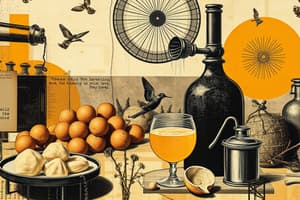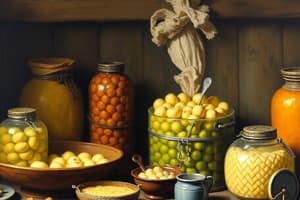Podcast
Questions and Answers
What initial sources did Egyptian brewers rely on for yeast in fermentation?
What initial sources did Egyptian brewers rely on for yeast in fermentation?
- Yeasts isolated from laboratory cultures
- Commercial yeast strains
- Yeasts from the air or fruit and cereal skins (correct)
- Yeasts obtained from neighboring brewers
What significant advancement in microbiology contributed to the understanding of fermentation in the 17th century?
What significant advancement in microbiology contributed to the understanding of fermentation in the 17th century?
- The invention of the microscope by Anton van Leeuwenhoek (correct)
- The development of chemical synthesis
- The introduction of antibiotics in brewing
- The discovery of enzymes in yeast fermentation
How did the methods of brewing change over time according to the content?
How did the methods of brewing change over time according to the content?
- From relying solely on environmental yeasts to using pure yeast strains (correct)
- From the use of ancient techniques to highly automated systems
- From small batch brewing to large scale production without any shift in technique
- From traditional fermentation to chemical fermentation processes
What was the primary characteristic of microbial food production in its early stages?
What was the primary characteristic of microbial food production in its early stages?
What was a consequence of the cultural practices in brewing by Egyptian brewers?
What was a consequence of the cultural practices in brewing by Egyptian brewers?
What factor played a key role in transforming the understanding of fermentation processes?
What factor played a key role in transforming the understanding of fermentation processes?
What is the significance of sealing fermentation jars with clay?
What is the significance of sealing fermentation jars with clay?
Which of the following foods is produced through microbial fermentation?
Which of the following foods is produced through microbial fermentation?
What distinguishes the second wave of biotechnology from the first wave?
What distinguishes the second wave of biotechnology from the first wave?
During which century were many industrial compounds produced via microbial fermentation?
During which century were many industrial compounds produced via microbial fermentation?
Which of the following processes can be classified under microbial fermentation?
Which of the following processes can be classified under microbial fermentation?
What is one of the main challenges in open vat fermentation systems?
What is one of the main challenges in open vat fermentation systems?
Which of the following is NOT a biotechnological product derived from microbial fermentation?
Which of the following is NOT a biotechnological product derived from microbial fermentation?
What role do microbial processes play in waste treatment?
What role do microbial processes play in waste treatment?
Which process is used to control contaminating microorganisms in early industrial fermentation?
Which process is used to control contaminating microorganisms in early industrial fermentation?
Which microorganism is primarily responsible for the fermentation of tempeh?
Which microorganism is primarily responsible for the fermentation of tempeh?
What was one of the first uses of fermentation documented in ancient civilizations?
What was one of the first uses of fermentation documented in ancient civilizations?
Which ancient civilization is credited with baking leavened bread around 4000 BC?
Which ancient civilization is credited with baking leavened bread around 4000 BC?
What key element is involved in the design and optimal operation of a bioreactor?
What key element is involved in the design and optimal operation of a bioreactor?
What is one of the primary focuses of downstream processing in biotechnology?
What is one of the primary focuses of downstream processing in biotechnology?
In the context of industrial microbiology, what does the term 'fermentation plant design' primarily refer to?
In the context of industrial microbiology, what does the term 'fermentation plant design' primarily refer to?
The relief picture depicting scenes of baking and brewing is from which historical period?
The relief picture depicting scenes of baking and brewing is from which historical period?
Which of the following processes is NOT part of ancient bread-making as per the historical depictions?
Which of the following processes is NOT part of ancient bread-making as per the historical depictions?
In the context of microbial food production, what does 'scale up' refer to?
In the context of microbial food production, what does 'scale up' refer to?
Flashcards are hidden until you start studying
Study Notes
Fermentation Process
- Finished beer is poured from vats into pottery jars, sealed with clay, and stored.
- Early brewing relied on wild yeasts from the environment, later transitioning to pure yeast strains.
Evolution of Biotechnology
- First wave: Microbial production of food and beverages; initially a craft, with microorganisms yet to be understood.
- By the 17th century, the role of microorganisms in wine and beer production became recognized, aided by Anton van Leeuwenhoek's microscope.
Historical Context of Fermentation
- Sumerians and Babylonians consumed beer as early as 6000 BC.
- Egyptians were baking leavened bread around 4000 BC.
- Wine existed in the Near East by the time of the Book of Genesis.
Brewing and Baking Techniques in Ancient Egypt
- Depictions from the 5th Dynasty show the processes of baking and brewing.
- Baking techniques included the pounding and grinding of wheat, soaking flour for malting, kneading leavened dough, and baking.
Diverse Fermented Products
- Various fermented foods include yoghurt, soy sauce, kimchi, tempeh, and natto.
- These products exemplify microbial contributions to food processing.
Industrial Fermentation Developments
- Second wave of biotechnology involved open vat fermentation under non-sterile conditions.
- By the late 19th century, microbial fermentation produced significant industrial compounds like ethanol and acetic acid.
- Control of microbial contamination was achieved through ecological manipulation rather than advanced engineering.
Studying That Suits You
Use AI to generate personalized quizzes and flashcards to suit your learning preferences.




